Western Pennsylvania birders who have been active at least since the early 1990s will remember fondly the heydays of shorebirding on Gull Point at Presque Isle State Park, Erie County. Gull Point was once considered one of the United States' top birding spots east of the Mississippi River by more than a few of the country's top birders. I remember walking to the Point as a child and teenager in the 1980s with the kind of over-the-top, greedy anticipation only a juvenile homo sapiens can muster... wondering, will today be the day that another Snowy Plover would decide to grace the shores of Presque Isle (as one did in 1986), or would the day's highlight just be another Piping Plover? Maybe today we would find a Curlew Sandpiper, or a Ruff, or an Oystercatcher! At Gull Point, nothing seemed too far-fetched.
Shorebirding Around Western Pennsylvania — Past and Present
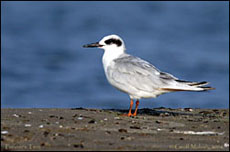
That was then. In the years since, the ecology at Gull Point has been dramatically altered, following the installation in the early 1990s of five dozen breakwaters (essentially, big rock piles) all along the northern lakeshore of Presque Isle.
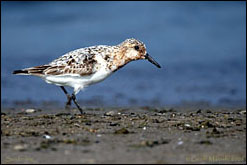 In
the years before the breakwaters, the prevailing westerly
Lake Erie winds, together with the relentless pressure of
Lake Erie itself, drove a conveyor belt of drifting sand to
the eastern end of Presque Isle's peninsula at Gull Point.
In fact, throughout its 11,000-year history, the entire
peninsula has actually spent most of its existence as an
island, and has slowly been migrating eastward along the
Lake Erie shoreline in this manner ever since the glaciers
receded. The sand delivered to Gull Point by the lake was
taken at the expense of the beaches along the peninsula's
narrow western neck, so much so that if left unchecked, the
western beaches might have eroded so dramatically in the
next few decades that Lake Erie might have able to breach
the peninsula in such dramatic fashion as to revert Presque
Isle State Park back into an island for the foreseeable
future.
In
the years before the breakwaters, the prevailing westerly
Lake Erie winds, together with the relentless pressure of
Lake Erie itself, drove a conveyor belt of drifting sand to
the eastern end of Presque Isle's peninsula at Gull Point.
In fact, throughout its 11,000-year history, the entire
peninsula has actually spent most of its existence as an
island, and has slowly been migrating eastward along the
Lake Erie shoreline in this manner ever since the glaciers
receded. The sand delivered to Gull Point by the lake was
taken at the expense of the beaches along the peninsula's
narrow western neck, so much so that if left unchecked, the
western beaches might have eroded so dramatically in the
next few decades that Lake Erie might have able to breach
the peninsula in such dramatic fashion as to revert Presque
Isle State Park back into an island for the foreseeable
future.
The constant influx of new sand and seasonal washovers kept Gull Point in a state of continual change. The end result was shorebird habitat of the highest order, forming one of the more important stopover points for migrating shorebirds in the Great Lakes area.
The breakwaters were designed to halt the erosion of the
sandy beaches all along Presque Isle's length by reducing
the energy with which the prevailing west-to-east Lake Erie
waves hit the Presque Isle shoreline. The ultimate goal,
besides preventing an
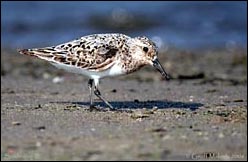 unrecoverable
breach of the peninsula, was to sustain the beaches for use
by the hundreds of thousands of vacationers - and their
dollars — who crowd the state park in the summer seeking the
only real "seashore" available in Pennsylvania. In this
function, the breakwaters are remarkably effective, but like
many developments of human design, they have exacted a heavy
toll on rare and valuable native habitat. In this case, Gull
Point and the shorebirds that frequented its flats were the
victims.
unrecoverable
breach of the peninsula, was to sustain the beaches for use
by the hundreds of thousands of vacationers - and their
dollars — who crowd the state park in the summer seeking the
only real "seashore" available in Pennsylvania. In this
function, the breakwaters are remarkably effective, but like
many developments of human design, they have exacted a heavy
toll on rare and valuable native habitat. In this case, Gull
Point and the shorebirds that frequented its flats were the
victims.
I remember an afternoon walk to Gull Point following a cold front in August 1990, one year after breakwater construction began, where we found 5,000 shorebirds strewn all over the acres and acres of sand and tidal pools at the Point. My trip list from that day tells me that we recorded twenty species of shorebirds, but even more impressive and unforgettable was the sheer number. The birds were approachable, photographable (although in those days I did not pack a camera), and unimaginable.
But the breakwaters put an end to all of that. Today,
with the beach sand safely guarded and the days of massive
Gull Point washovers now fifteen years gone by, plant
succession has claimed Gull Point's flats and relegated
the shorebirds to a comparatively tiny sandbar that sits at
the very end of the tip. This sandbar is fed by what little
is left of the former conveyor belt
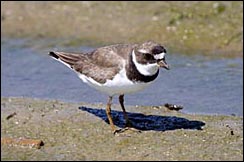 of sand, which does persist today but to a much, much
smaller effect. Despite this, Gull Point still does produce
excellent birds, like Hudsonian Godwits and Buff-breasted
Sandpipers, Parasitic Jaegers and Laughing Gulls. It remains
probably the single most likely place in Pennsylvania for a
vagrant shorebird to appear, but shorebirding there now is
more of a battle of attrition than anything else, where a
birder is compelled to wait for hours and days, and hope
that this day will be that one magical day a season when
lighting strikes and a really good bird lands for a few
hours. Despite this potential, those who remember yesteryear
realize that today, Gull Point barely qualifies even to be
called a shadow of its former self.
of sand, which does persist today but to a much, much
smaller effect. Despite this, Gull Point still does produce
excellent birds, like Hudsonian Godwits and Buff-breasted
Sandpipers, Parasitic Jaegers and Laughing Gulls. It remains
probably the single most likely place in Pennsylvania for a
vagrant shorebird to appear, but shorebirding there now is
more of a battle of attrition than anything else, where a
birder is compelled to wait for hours and days, and hope
that this day will be that one magical day a season when
lighting strikes and a really good bird lands for a few
hours. Despite this potential, those who remember yesteryear
realize that today, Gull Point barely qualifies even to be
called a shadow of its former self.
So we Western Pennsylvania birders, landlocked and starved for good shorebirding, are forced to look elsewhere for a glimpse of past glory. In drought years, Shenango Reservoir in Mercer County is probably the next-best place to Gull Point in Western PA, and has been known to have some truly excellent seasons, but there hasn't been any real shorebird habitat there since 2002, and there hasn't been a really good season since 1999. Even when there are good conditions at Shenango, circumstances usually dictate that the reservoir is not drawn down far enough to create good shorebird habitat until late August or early September, after two-thirds of the shorebird migration has already passed. The Imperial Grasslands in Allegheny County likewise have a history of producing outstanding shorebirds, but the density of birds there is low, and the entire location is probably only a few years away from disappearing forever under the ever-expanding suburban streets of Pittsburgh.
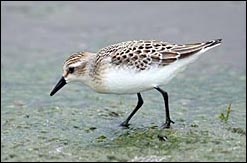 So
we keep looking. Fortunately, in the last four years, we
have come to know an excellent location in our neighboring
state to the west, at Conneaut Harbor in the town of
Conneaut, Ashtabula County, Ohio. Always known among Ohio
birders as a good shorebirding spot in years where the water
level in Lake Erie is favorable, this little gem of a
mudflat, just two miles over the PA border on the Ohio
lakeshore, has been an outstanding shorebirding destination
since 2003. Here, as nowhere else since Gull Point in its
prime, do western Pennsylvania birders have such an
opportunity to study shorebirds - in numbers, up close, and
without effort.
So
we keep looking. Fortunately, in the last four years, we
have come to know an excellent location in our neighboring
state to the west, at Conneaut Harbor in the town of
Conneaut, Ashtabula County, Ohio. Always known among Ohio
birders as a good shorebirding spot in years where the water
level in Lake Erie is favorable, this little gem of a
mudflat, just two miles over the PA border on the Ohio
lakeshore, has been an outstanding shorebirding destination
since 2003. Here, as nowhere else since Gull Point in its
prime, do western Pennsylvania birders have such an
opportunity to study shorebirds - in numbers, up close, and
without effort.
When Lake Erie's water level is just right (more or
less) and silt from Lake Erie's currents is allowed to
build in the harbor, as it has been for the last four
summers, the western side of the harbor becomes not a body
of water or a dry patch of dirt, but a mudflat, which is
sometimes quite extensive. From July through September, this
mudflat is attended by shorebirds, sometimes numbering in
the hundreds. Further, it is possible to drive a passenger
car right out to the waterline, making Conneaut Harbor a
rare opportunity anywhere away from the ocean, where one can
literally drive up to a big flock of shorebirds, get out of
the car, and wander among them. The opportunities for close
range study and photography are abundant, and in fact
Conneaut Harbor is known and used (in good years) by some
professional photographers. Truly, its accessibility and
excellent habitat make it one of the very best places
anywhere for shorebird photography. That fact this little
spot is only two hours from downtown Pittsburgh makes
Conneaut a "must see" for any modern-day Western
Pennsylvania birder who wants to study shorebirds.
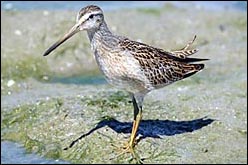
Of course, the ease with which the mudflats can be accessed is a double-edged sword. Conneaut Harbor is a "multiple use area," where local residents go to sunbathe, fly kites, play with their dogs, even parasail. It is also called "Harbor" for a reason — there is an extensive harbor where hundreds of recreational sailors congregate in summer, perhaps for a day of fishing, or maybe just for a joyride on a Great Lake. Most users of the harbor are nice people and are not a disturbance. Unfortunately, Conneaut Harbor also attracts people with little regard for others or the environment around them, and occasionally there have been incidents in which some visitors (mostly teenagers or adults of teenage maturity) have deliberately disturbed the birds and birders just to be "funny." An early morning visit is the best way to avoid these unsavory types.
2003 was a banner year for shorebirds at Conneaut Harbor,
and the mud has slowly been receding in the three years
since and turning back into hard, dry dirt. Despite this,
the shorebird habitat there remains excellent. The entire
western half of the harbor is seems to be under constant
threat of dredging, which of course could have a
significantly deleterious effect on the shorebird habitat;
however, increasingly this threat seems to be idle, and many
people associated with the harbor do not see dredging as a
possibility there for the foreseeable future, though there
are no guarantees. Whatever the future brings, as of summer
2006, the shorebirds are still there in good numbers, and
hopefully will be for at least the next year or two, or
longer.

On a typical summer day, depending on which species are moving through in bulk at the time, one can plan to see all the expected shorebirds, like Short-billed Dowitcher, Least, Semipalmated, Pectoral and Solitary Sandpipers, Semipalmated Plovers, Sanderlings, both Yellowlegs, etc. Willets and White-rumped, Baird's, and Stilt Sandpipers are also regular and individuals often hang around for a few days at a time. Even American Avocets are annual in numbers, usually with a few groups of anywhere from one to ten landing for a day or two throughout July and August. Conneaut also has proven that it can attract the "goodies." In the last three years, Hudsonian and Marbled Godwits, Whimbrel, all three Phalaropes, Long-billed Dowitcher, Western Sandpiper, Buff-breasted Sandpiper, and Red Knot were all recorded, in many cases more than once a year. In July 2006, two different Piping Plovers were found. There even was a Little Gull present much of July 2004, unheard of in Pennsylvania at that season.
But even if no rarities are present, shorebirding at Conneaut Harbor is still an invaluable experience. Nowhere else within a two-hundred mile radius of Pittsburgh can a birder study, at such close range and with such ease, the finer details of shorebird plumages and behavior. More can be learned by a new birder in one morning at this little harbor than can be in a month of reading a book. And for those us who truly love the shorebirds for their astounding beauty and resilience, which I assume is all of us, a morning at Conneaut will leave a lasting impression. Bring your muckboots, your telescope, and your camera, and be prepared to see shorebirds in a way you may never have seen them before.
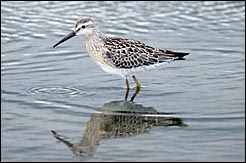 To reach Conneaut Harbor from Pittsburgh, take I-79 north to
exit 147B/Conneaut Lake/US-6 West/US-322 West. Go west on
US-6 for about 20 miles into Ohio. About two miles into
Ohio, turn right (north) onto Ohio Route 7, and proceed
another 16 miles to the town of Conneaut. Once in Conneaut,
continue to follow signs for Ohio-7. At State St., turn
Right (east) for 1/4 mile following the Ohio-7 signs; 3
blocks later, turn Left (north) and follow Ohio-7 about 1 1/2
miles until it becomes the entrance road to the Harbor. To
reach the beach and mudflats by car, bear left into and
drive through the main Harbor parking area, and continue on
the road that goes west from the parking area. Eventually
the road bends left (south); at this bend, stay straight
proceeding onto a bumpy dirt road, and follow it for a
thousand feet or so. Eventually it will open up onto a vast
beach/flat area, and other cars will likely be present. From
here you can drive anywhere you feel comfortable taking your
car. Lately the best habitat had been all the way at the
end, near the harbor itself. Mornings are better both for
lighting and because there are less people.
To reach Conneaut Harbor from Pittsburgh, take I-79 north to
exit 147B/Conneaut Lake/US-6 West/US-322 West. Go west on
US-6 for about 20 miles into Ohio. About two miles into
Ohio, turn right (north) onto Ohio Route 7, and proceed
another 16 miles to the town of Conneaut. Once in Conneaut,
continue to follow signs for Ohio-7. At State St., turn
Right (east) for 1/4 mile following the Ohio-7 signs; 3
blocks later, turn Left (north) and follow Ohio-7 about 1 1/2
miles until it becomes the entrance road to the Harbor. To
reach the beach and mudflats by car, bear left into and
drive through the main Harbor parking area, and continue on
the road that goes west from the parking area. Eventually
the road bends left (south); at this bend, stay straight
proceeding onto a bumpy dirt road, and follow it for a
thousand feet or so. Eventually it will open up onto a vast
beach/flat area, and other cars will likely be present. From
here you can drive anywhere you feel comfortable taking your
car. Lately the best habitat had been all the way at the
end, near the harbor itself. Mornings are better both for
lighting and because there are less people.
— by Geoff Malosh





